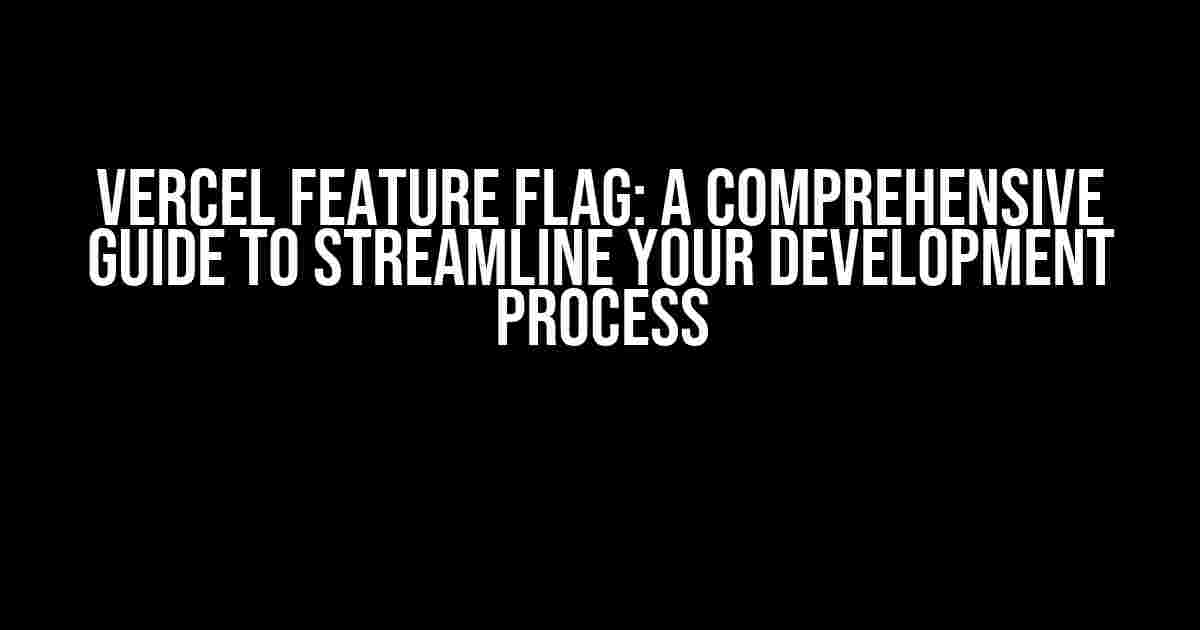Are you tired of manually managing feature flags in your application? Do you struggle to keep track of multiple flags across different environments? Look no further than Vercel Feature Flag, a game-changing tool that simplifies the feature flagging process and takes your development workflow to the next level. In this article, we’ll delve into the world of Vercel Feature Flag, exploring its benefits, features, and implementation steps.
What is Vercel Feature Flag?
Vercel Feature Flag is a powerful tool offered by Vercel, a popular platform for building and deploying modern web applications. It allows developers to manage feature flags dynamically, providing a seamless way to toggle features on and off across different environments, users, or iterations. With Vercel Feature Flag, you can easily control the rollout of new features, A/B test variations, and manage multiple deployments without modifying your codebase.
Benefits of Using Vercel Feature Flag
The advantages of using Vercel Feature Flag are numerous. Here are some of the most significant benefits:
-
Effortless Rollout Management: With Vercel Feature Flag, you can manage feature rollouts with ease, eliminating the need for manual code changes or complex infrastructure updates.
-
Simplified A/B Testing: Create and manage A/B tests effortlessly, without modifying your code or requiring additional infrastructure.
-
Faster Time-to-Market: Vercel Feature Flag enables you to deploy new features quickly, reducing the time it takes to get your application to market.
-
Improved Collaboration: Developers, product managers, and stakeholders can work together seamlessly, using feature flags to manage and track feature development.
Setting Up Vercel Feature Flag
Getting started with Vercel Feature Flag is a breeze. Follow these steps to set up and start using feature flags in your application:
-
Sign up for a Vercel Account: If you haven’t already, create a Vercel account and set up a new project.
-
Install the Vercel CLI: Install the Vercel Command-Line Interface (CLI) using npm or yarn:
npm install -g @vercel/clioryarn global add @vercel/cli. -
Create a New Feature Flag: Using the Vercel CLI, create a new feature flag:
vercel feature-flag create. -
Configure Your Feature Flag: Define the conditions and rules for your feature flag using the Vercel CLI or the Vercel dashboard.
Vercel Feature Flag Configuration Options
Vercel Feature Flag provides a range of configuration options to fine-tune your feature flagging experience:
| Configuration Option | Description |
|---|---|
name |
The name of your feature flag. |
description |
A brief description of your feature flag. |
enabled |
Whether the feature flag is enabled or disabled. |
conditions |
The conditions under which the feature flag should be applied. |
rules |
The rules that determine which users or environments should receive the feature. |
Implementing Vercel Feature Flag in Your Application
Once you’ve set up your feature flag, it’s time to integrate it into your application. Here’s an example of how to use Vercel Feature Flag in a Next.js application:
import { getFeatureFlag } from '@vercel/feature-flags';
function MyComponent() {
const featureFlag = getFeatureFlag('my-feature-flag');
if (featureFlag.enabled) {
return <div>My feature is enabled!</div>
} else {
return <div>My feature is disabled.</div>
}
}
Using Vercel Feature Flag with Other Vercel Tools
Vercel Feature Flag seamlessly integrates with other Vercel tools, such as Vercel Edge Network and Vercel Analytics. Here’s how you can leverage these integrations:
-
Vercel Edge Network: Use Vercel Feature Flag to manage feature rollouts across different edge networks, ensuring that users receive the correct feature set based on their location or network.
-
Vercel Analytics: Track feature adoption and performance metrics using Vercel Analytics, and use feature flags to optimize your application’s performance and user experience.
Best Practices for Using Vercel Feature Flag
To get the most out of Vercel Feature Flag, follow these best practices:
-
Use Descriptive Names: Use descriptive names for your feature flags to ensure easy identification and management.
-
Keep Feature Flags organized: Organize your feature flags by category, environment, or iteration to simplify management and tracking.
-
Use Conditions Wisely: Use conditions judiciously to target specific users, environments, or iterations, and avoid over-complexity.
-
Test and Validate: Thoroughly test and validate your feature flags to ensure correct behavior and avoid unintended consequences.
Conclusion
Vercel Feature Flag is a powerful tool that streamlines the feature flagging process, enabling you to focus on building innovative applications without the hassle of manual flag management. With its ease of use, flexibility, and seamless integration with other Vercel tools, Vercel Feature Flag is an essential addition to any development workflow. Try it out today and see the difference it can make in your development process!
By following the instructions and best practices outlined in this article, you’ll be well on your way to mastering Vercel Feature Flag and taking your development workflow to new heights. Happy building!
Frequently Asked Question
Get the most out of Vercel’s Feature Flag – unlock the secrets to seamless deployment and experiment with confidence!
What is Vercel’s Feature Flag, and how does it benefit my development workflow?
Vercel’s Feature Flag is a game-changing tool that lets you toggle features on or off, without requiring code deployments. This means you can experiment with new features, test their performance, and roll back if needed, all without disrupting your users. It’s a must-have for any development team looking to improve their workflow and reduce deployment anxiety!
How do Feature Flags help with experimentation and A/B testing?
Feature Flags allow you to create multiple variations of a feature, toggle them on or off, and track performance metrics. This enables seamless A/B testing, experimentation, and validation of hypotheses without requiring multiple code deployments. You can also use Feature Flags to test new features on a small percentage of users, ensuring a smooth rollout and minimizing the risk of downtime.
Can I use Vercel’s Feature Flag for canary releases or phased rollouts?
Absolutely! Feature Flags are perfect for canary releases or phased rollouts. You can toggle a feature on for a small percentage of users, monitor performance, and gradually roll it out to a larger audience. This approach reduces the risk of deployment failures and ensures a smooth transition to new features.
How do Feature Flags improve collaboration between developers, product managers, and designers?
Feature Flags create a common language and understanding across teams. Developers can build features, product managers can prioritize and validate, and designers can iterate on user experiences – all without requiring code deployments or manual configuration. This fosters a culture of collaboration, enabling teams to work together more effectively and deliver better user experiences.
Are Feature Flags compatible with my existing development tools and workflows?
Yes! Vercel’s Feature Flag is designed to integrate seamlessly with your existing development tools and workflows. It supports popular frameworks and libraries, and can be easily incorporated into your CI/CD pipelines. This means you can start using Feature Flags without disrupting your existing development flow.


